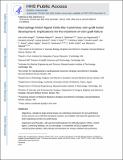Macrophage Notch Ligand Delta-Like 4 Promotes Vein Graft Lesion Development, Implications for the Treatment of Vein Graft Failure
Author(s)
Koga, Jun-ichiro; Nakano, Toshiaki; Figueiredo, Jose-Luiz; Zhang, Hengmin; Decano, Julius; Khan, Omar F.; Niida, Tomiharu; Iwata, Hiroshi; Aster, Jon C.; Yagita, Hideo; Ozaki, C. Keith; Aikawa, Masanori; Anderson, Daniel Griffith; Dahlman, James E.; ... Show more Show less
DownloadAnderson_Macrophage notch.pdf (3.453Mb)
OPEN_ACCESS_POLICY
Open Access Policy
Creative Commons Attribution-Noncommercial-Share Alike
Terms of use
Metadata
Show full item recordAbstract
Objective—Despite its large clinical impact, the underlying mechanisms for vein graft failure remain obscure and no effective therapeutic solutions are available. We tested the hypothesis that Notch signaling promotes vein graft disease.
Approach and Results—We used 2 biotherapeutics for Delta-like ligand 4 (Dll4), a Notch ligand: (1) blocking antibody and (2) macrophage- or endothelial cell (EC)–targeted small-interfering RNA. Dll4 antibody administration for 28 days inhibited vein graft lesion development in low-density lipoprotein (LDL) receptor-deficient (Ldlr−/−) mice, and suppressed macrophage accumulation and macrophage expression of proinflammatory M1 genes. Dll4 antibody treatment for 7 days after grafting also reduced macrophage burden at day 28. Dll4 silencing via macrophage-targeted lipid nanoparticles reduced lesion development and macrophage accumulation, whereas EC-targeted Dll4 small-interfering RNA produced no effects. Gain-of-function and loss-of-function studies suggested in vitro that Dll4 induces proinflammatory molecules in macrophages. Macrophage Dll4 also stimulated smooth muscle cell proliferation and migration and suppressed their differentiation.
Conclusions—These results suggest that macrophage Dll4 promotes lesion development in vein grafts via macrophage activation and crosstalk between macrophages and smooth muscle cells, supporting the Dll4–Notch axis as a novel therapeutic target.
Date issued
2015-09Department
Massachusetts Institute of Technology. Institute for Medical Engineering & Science; Massachusetts Institute of Technology. Department of Chemical Engineering; Koch Institute for Integrative Cancer Research at MITJournal
Arteriosclerosis, Thrombosis, and Vascular Biology
Publisher
Wolters Kluwer Health, Inc.
Citation
Koga, Jun-ichiro, Toshiaki Nakano, James E. Dahlman, Jose-Luiz Figueiredo, Hengmin Zhang, Julius Decano, Omar F. Khan, et al. “Macrophage Notch Ligand Delta-Like 4 Promotes Vein Graft Lesion DevelopmentSignificance.” Arteriosclerosis, Thrombosis, and Vascular Biology 35, no. 11 (September 24, 2015): 2343–2353. © 2015 American Heart Association, Inc.
Version: Author's final manuscript
ISSN
1079-5642
1524-4636